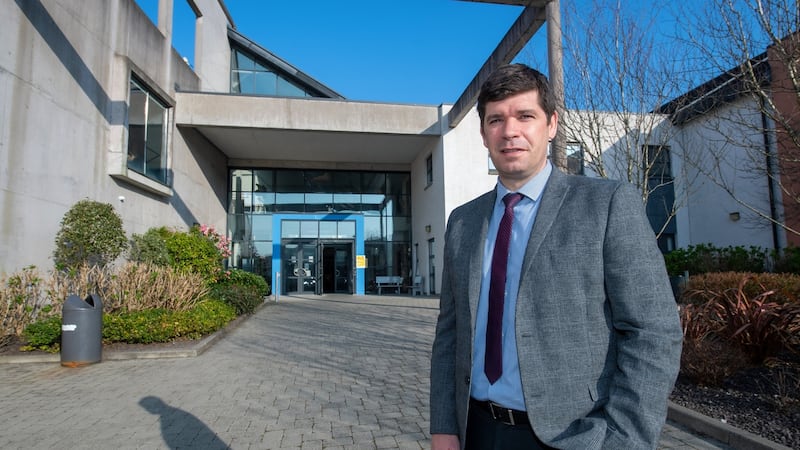Sutton Park School in north Dublin used to have an “ultra liberal” approach to smartphones in class for students. Not any more.
“I said to any parents who questioned it at the time that if we didn’t teach them how to use mobile phones responsibly, when would it ever happen?” says principal Ronan Walsh.
Phones pinging and vibrating in classroom and students messaging each other was one thing. His biggest concern, however, was the impact on students’ social interaction.
“I had to acknowledge that students at break time were sitting on the floor, not talking to each other; they were just scrolling away on their phones,” Walsh says.
Now, the school policy is that phones must be off at all times and left face down on the student’s desk. Pupils are not allowed to use them at lunchtime and, if confiscated, they will only be returned at the end of the school day.
“That’s as good as we can do,” he says.
These days there are more meaningful interactions at lunchtime, fewer distractions during class and less time spent on screens.
The north Dublin school is far from alone. Once smartphones were seen in education as shiny learning tools of the future, fostering self-directed research and collaboration. These days, more and more schools are moving to either ban or restrict their use in the face of distraction and classroom disruption.

In the UK they are going further still. On Monday last, minister for education Gillian Keegan released guidance on banning mobile phones across second level schools in an attempt to improve behaviour in classrooms.
It comes against a backdrop of mounting concern over the impact of social media on students’ wellbeing, screen-induced sleep deprivation and declining mental health.
The murder in the UK of 16-year-old transgender girl Brianna Ghey by two other teens has been a tipping point. Her mother, who believes her daughter was vulnerable after spending so much time online, has led calls for a ban on access to social media for under-16s.
Florida, meanwhile, has moved towards enacting one of the strictest bans on children’s use of social media in the United States, with a Bill to keep under-16 off such platforms sent to the governor.
Many school principals are doubtful that a blanket ban on smartphones would work in Ireland on the basis they are so embedded in young people’s lives nowadays, either as communication devices or simply to tell the time.
As result, most are taking a more nuanced approach. Jonathon Walker, principal of Ringsend College, a Deis secondary school in Dublin’s south inner city, saw first-hand how well-meaning measures such as expecting students to be responsible users of phones did not work.
Before his time as principal, the school had an “out and off” policy, with posters exhorting students to turn phones off.
“It was a terrible idea,” Walker says. “They were trying to respond to what was becoming problem, but no one’s phone was off. Half of them were out ... it was carnage.”
The school recently tried a new approach: “phone away boxes”, or see-though containers mounted on the front of students’ lockers. Pupils are expected to deposit their phones in them on arrival and can retrieve them at lunchtime or when leaving school.
If a phone is found on a student at other times, it may be taken away for the school day; for a second offence, a parent – in theory, at least – is requested to retrieve the phone.
Walker says the policy is working well, with fewer distractions, but says it takes manpower to enforce it. If there are no checks carried out for a few days, compliance rates can quickly plunge.
More broadly, besides the educational impact, Walker worries about how constant access to social media is often colonising the minds of students and negatively affecting their self-esteem and body dissatisfaction.
“It’s constantly pinging away in their pockets ... I do think there is a massive correlation between this and issues like gender dysphoria, wellbeing and mental health issues. They are constantly being exposed to the Instagram life, looking at others posting about how everything is brilliant. It’s just not real, but it’s very hard not to buy into that,” Walker says.
While teens have always been a target for advertisers, he feels the influence of social media advertisements is fuelling a general and physical appearance anxiety.
“There’s the lip fillers, tanning beds, vaping, Balenciaga runners, Canada goose jackets, the latest iPhone models. They’re being overexposed to this glam life which isn’t real,” he says.
At Alexandra College, a fee-charging all-girls school in South Dublin, students are required to place their phone in magnetic pouches on arrival. These are locked and cannot be opened until end of the day.
“Some are like addicts; there’s a big rush and it’s straight into the bags to get them, and they’re on to their phones. Not all, but many of them,” says principal Barbara Ennis.
The school is a largely a phone-free zone most of the time, she says. This has boosted social interaction and reduced distraction and discipline issues – but some students still find ways around the rules, either by using pins to unlock the bags or having a second “burner” phone.
Ennis says the school is not anti-technology. Each student has access to an iPad which, she says, can be very useful to research topics that arise in class. Yet, despite security settings, these too can be used for “nefarious” purposes by some tech-savvy teens who link them to their phones.
“We have to constantly review our policies ... but a full ban would just make the phones even more alluring,” Ennis says.
The Department of Education does not have plans to introduce a UK-style ban smartphones at secondary schools.
However, a spokeswoman said all schools are advised to have an acceptable use policy in place that sets out rights, privileges, responsibilities and sanctions associated with the use of smartphones and personal devices.
For Éamonn Fitzmaurice, principal of Pobalscoil Chorca Dhuibhne in Dingle, Co Kerry, it is all about striking the right balance.
His school also uses magnetic pouches for phones and says they are sometimes used in class, depending on the individual teacher.
Smartphones, whether we like it our not, he says, will be a part of young people’s lives. There is a responsibility, then, on schools and parents, especially, to model good behaviour.

Ironically, he says, most students seem to appreciate the break they get from a frantic world of online notifications and alerts.
“If it’s on, it’s human nature to want to check everything. They realise that having a break helps them to concentrate and that they can survive without checking in online every five minutes. They might not fully appreciate that now, but they will further down the line,” Fitzmaurice says.
Are smartphones damaging young people’s mental health?
Something is going wrong for Irish teenagers. Students’ sense of wellbeing and belonging to school in Ireland has declined significantly over the past decade at the same time that smartphone use has become ubiquitous among teenagers.
Ireland’s most comprehensive study of young people’s mental health and wellbeing is the My World study, developed by University College Dublin’s school of psychology and mental health charity Jigsaw, based on the responses of more than 19,000 young people between 2012-2019.
It found that levels of anxiety and depression rose significantly among 12- to 19-year-olds between 2012-2019, while levels of self-esteem, resilience and optimism fell.
For example, the proportion of adolescents who fell into the severe and very severe categories for depression rose from 8 to 16 per cent, while those with anxiety increased from 11 to 22 per cent.
Similar trends are evident in the US and UK.
Among the leading proponents of the theory that having always-on access to social media is harming children’s mental health is Jean Twenge, professor of psychology at San Diego State University, and her regular co-author Jonathan Haidt.
Prof Twenge has pointed to a change in the way teens spend their time outside school starting from the early 2010s which coincides with a downward slide in mental health and increased suicidal ideation and self-harm among young people.
She argues that increased access to social media began to displace in-person gatherings, drive social comparison and body image issues, disrupt sleep patterns and prompt more cases of cyberbullying.
[ Parents to be encouraged not to buy smart phones for primary school childrenOpens in new window ]
Many studies also show that the more time teens spend on social media, the worse their mental health is. The gradient tends to be steepest for girls, who also spend much more time on social media than boys.
However, some academics say that while these findings point to a correlation between a decline in teen mental health and increased social media use, they do not point to a causal link.
Most reviews of the studies on social media use and adolescents’ mental health find the links to be “weak” and “inconclusive” or “weighed down by a lack of quality” and “conflicting evidence.”
Alongside the rise in social media use, some suggest other possible factors for decline in teen mental health include a reduction in stigma around mental ill health; greater awareness about anxiety and depression; and changes in diagnostic criteria for mental health issues.
- Follow The Irish Times education section on Facebook and X (Twitter) and stay up to date












